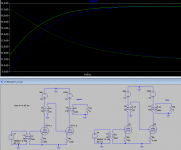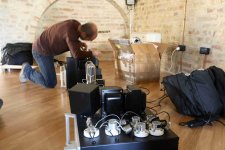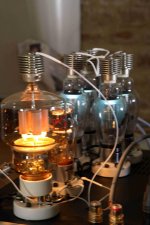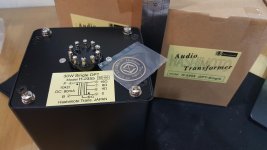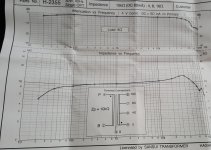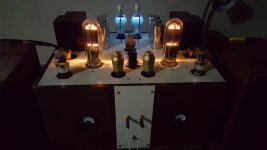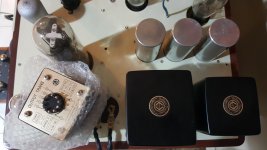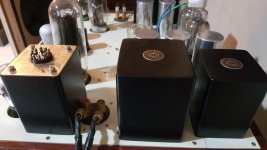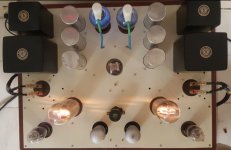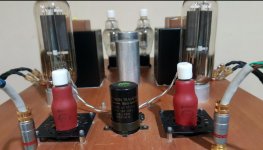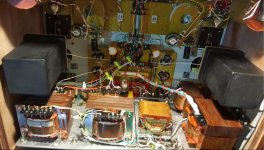I am in the process of planning my next project. A project to dwarf all other projects.
211 driving a 211. I have been able to get an idea of transformers I need and have been able to find good operating points.
Has anyone run 211 tubes at low voltages? I find that running the driver 211 at high B+ and high bias causes rolls off. but low bias, low voltage raises f3 by almost 10dB.
The graphic provided shows two possibilities.
The lower bias/B+ lowers f3 by 10dB to almost 30Hz.
The right runs higher B+ and higher bias and f3 is 40Hz.
The PSU is going to be insane, going to use Rod Coleman filament Regulators and insane B+ supplies. Thing is gonna cost a ton to build but why not.
211 driving a 211. I have been able to get an idea of transformers I need and have been able to find good operating points.
Has anyone run 211 tubes at low voltages? I find that running the driver 211 at high B+ and high bias causes rolls off. but low bias, low voltage raises f3 by almost 10dB.
The graphic provided shows two possibilities.
The lower bias/B+ lowers f3 by 10dB to almost 30Hz.
The right runs higher B+ and higher bias and f3 is 40Hz.
The PSU is going to be insane, going to use Rod Coleman filament Regulators and insane B+ supplies. Thing is gonna cost a ton to build but why not.
Attachments
hey, I built a preamp using the 211 at 500V/30ma (with CCS and colemans) and transformer loaded: it sounded very nice.
I also built half a dozen of variations of direct coupled 801A to 211/GM70/813/EIMACs and I would not suggest to build such a beast to anybody. Tons of irons and capacitors, unimaginable heat, buckets of $ but, oh man!, that amp was fabulous.
I also built half a dozen of variations of direct coupled 801A to 211/GM70/813/EIMACs and I would not suggest to build such a beast to anybody. Tons of irons and capacitors, unimaginable heat, buckets of $ but, oh man!, that amp was fabulous.
sort of! I had the 304TL version there but they were not yet directly coupled. i dismantled those amps and rebuilt them as 4 chassis and stacked the output tube on top of the driver. 1500V 
Me assembling the system in Monterubbiano (and fixing a smoked choke in the PSU) and a close up of the 304TL and 801A (in the background the 866A).
Me assembling the system in Monterubbiano (and fixing a smoked choke in the PSU) and a close up of the 304TL and 801A (in the background the 866A).
Attachments
The OT is critical for the 211 design. Because of the large internal resistance of tube. But theese 110Hy is good and minimum...
Problem is that tube needs larger undistorted input signal for full power. So 211 has about 6X ampification gain in the circuit. That is not enough for the driver. You can not consider somethig as driver stage including step up transformer at the front...
I suggest to find another tube for real driver, and if You need galvanic isolation use 1:1 input transformer.
211 has not high dynamic capacitance so the driver impedance should be calculated with this datas.
I considered earlyer a design with 4242A tube pretty much similar to 211, so i had the same questions about the driver tube...
What is the value of -Ug in Your example?
Problem is that tube needs larger undistorted input signal for full power. So 211 has about 6X ampification gain in the circuit. That is not enough for the driver. You can not consider somethig as driver stage including step up transformer at the front...
I suggest to find another tube for real driver, and if You need galvanic isolation use 1:1 input transformer.
211 has not high dynamic capacitance so the driver impedance should be calculated with this datas.
I considered earlyer a design with 4242A tube pretty much similar to 211, so i had the same questions about the driver tube...
What is the value of -Ug in Your example?
I find that running the driver 211 at high B+ and high bias causes rolls off. but low bias, low voltage raises f3 by almost 10dB.
You haven't bypassed the cathode resistor....
If you bypass it should not be different. Otherwise there is something wrong in the models you use.
hi,
I have this Custom the SE Output Transformer ordered to Hashimoto, with specification Primary Single Tap : 10kohm /80ma / 30 watt, will give enough room for my 211. They provide the Form of test results. I feel this is fair.
inductance is important in the frequency response (low) i seen, they have left more.but in my opinion of my Custom OTP HAshimoto, that this is enough balance and flat.
I have used many transformers from Hashimoto, I think this is not bad and good with the price. when we see other made-japan transformer with rare condition.
for the stock OPT of hashimoto OT does exist as you said, maybe they consider it from the price, but it can still be overcome with matching circuits and parts.
regards
ed
I have this Custom the SE Output Transformer ordered to Hashimoto, with specification Primary Single Tap : 10kohm /80ma / 30 watt, will give enough room for my 211. They provide the Form of test results. I feel this is fair.
inductance is important in the frequency response (low) i seen, they have left more.but in my opinion of my Custom OTP HAshimoto, that this is enough balance and flat.
I have used many transformers from Hashimoto, I think this is not bad and good with the price. when we see other made-japan transformer with rare condition.
for the stock OPT of hashimoto OT does exist as you said, maybe they consider it from the price, but it can still be overcome with matching circuits and parts.
regards
ed
Attachments
Last edited:
IMHO, that Hashimoto is good for a relatively small 211 amplifier. It's 30W @40Hz which means about 17W @30Hz if the tube runs at 80 mA. I consider 30Hz a better frequency to assess transformer capability.
It looks like it has a minimum inductance of 40H (very small signal). It will be a bit higher with signal.
If you run the 211 at 1000V/60mA you should be able to get about 10W in class A1 with low distortion. For 1000V supply the data sheet suggests 7.6K to get 12W. You will get that into a 6 ohm load which is a typical minimum impedance of a true 8 ohm speaker....
It looks like it has a minimum inductance of 40H (very small signal). It will be a bit higher with signal.
If you run the 211 at 1000V/60mA you should be able to get about 10W in class A1 with low distortion. For 1000V supply the data sheet suggests 7.6K to get 12W. You will get that into a 6 ohm load which is a typical minimum impedance of a true 8 ohm speaker....
Hi 45,
Thanks for your opinion, i like
My hashimoto OPT has 57.3H, this size is quite large compared to the Hashimoto H20-14U series.
I use this for Project Single ended 211. a small output power.
I still prefer the SE than a PP or PSE, in my opinion SE gave a nice sound,
my 211 have not reached optimal, because I only get B + 850V, because MY diy PT only get 1550V-ct, for next i will try to winding again but at now delayed due to busy.
Can you give suggestion for a good driver tube of choice for 211?
i have try used a pentode (Mullard EF6) as a single stage driver, that is not bad, i like its speed of course with a boost of 211.
but i am fanatical with triode which i think is correct ....
i have changed it with 2 stage driver using REN 904 (indirect Heated Triode) as input and 45 (little Mu but i get enough current) for swing bait on grid 211. i am still try and learning , Next.. looking for A VT25 for replace 45 when i making a new PT .......
regards
ed
test
YouTube
Thanks for your opinion, i like
My hashimoto OPT has 57.3H, this size is quite large compared to the Hashimoto H20-14U series.
I use this for Project Single ended 211. a small output power.
I still prefer the SE than a PP or PSE, in my opinion SE gave a nice sound,
my 211 have not reached optimal, because I only get B + 850V, because MY diy PT only get 1550V-ct, for next i will try to winding again but at now delayed due to busy.
Can you give suggestion for a good driver tube of choice for 211?
i have try used a pentode (Mullard EF6) as a single stage driver, that is not bad, i like its speed of course with a boost of 211.
but i am fanatical with triode which i think is correct ....
i have changed it with 2 stage driver using REN 904 (indirect Heated Triode) as input and 45 (little Mu but i get enough current) for swing bait on grid 211. i am still try and learning , Next.. looking for A VT25 for replace 45 when i making a new PT .......
regards
ed
test
YouTube
Attachments
Last edited:
VT25/10Y with thoriated tungsten filament would be my choice with a good interstage. The interstage is not a problem nowadays in fact a good winder can make you a wideband interstage with plenty of inductance. This is easier if SE-to-SE or PP-to-PP taking full advantage of bifilar winding. For example have a look at Monolith Magnetics. The IT-01 is designed for 25 mA DC and has got 100H inductance, frequency response from 7Hz to 110KHz (-3 dB) with typical 5K source impedance of 10Y and can deliver undistorted 80V rms (i.e. 226V peak-to-peak) down to 10Hz!
For the input tube then you have many options....also because the 10Y has very good gain.
For the input tube then you have many options....also because the 10Y has very good gain.
Last edited:
10Y (and my favourite 801) is good tube, but not a gain champion.
If you use it as IT coupled single stage, the step-up (about 1:3) IT is necessary, but difficult to make (for example 10k:30k at 25mA primary current) this IT.
Best choice to use step-up input transformer and -about- 1:1 IT.
Ps. I prefer CCS loaded high gain -trioded- pentode (D3a/E280F), cap. coupling to high voltage MOSFET (SiC) source follower as VAS stage.
If you use it as IT coupled single stage, the step-up (about 1:3) IT is necessary, but difficult to make (for example 10k:30k at 25mA primary current) this IT.
Best choice to use step-up input transformer and -about- 1:1 IT.
Ps. I prefer CCS loaded high gain -trioded- pentode (D3a/E280F), cap. coupling to high voltage MOSFET (SiC) source follower as VAS stage.
If you use it as IT coupled single stage, the step-up (about 1:3) IT is necessary, but difficult to make (for example 10k:30k at 25mA primary current) this IT.
You can't beat a bifilar 1:1 IT. 1:3 IT for a 10Y will be heavily compromised on its own. I haven't seen one with decent frequency response. Not a good choice at all.
The gain for the 10Y/801A is enough to have endless choice for the input stage and get a proper integrated amp.
No need for step-up input, unless one wants to do a 2 stage power amp with a specific and capable preamp. However the stages are always more than 2 in any case....so in the end the integrated amp is the simplest and possibly cheaper solution (but not worse by any means).
10Y (and my favourite 801) is good tube, but not a gain champion.
If you use it as IT coupled single stage, the step-up (about 1:3) IT is necessary, but difficult to make (for example 10k:30k at 25mA primary current) this IT.
Best choice to use step-up input transformer and -about- 1:1 IT.
Indeed a 1:3 IT is not a very good approach; FR will suffer because of high Rp.
Besides, drive current for the 211 grid will be 25:3= 8mA
By the way, 1:3 voltage ratio is 10k : 90k impedance ratio.....
You can't beat a bifilar 1:1 IT.
Depends....
I can wind a non bifilar 1:1 with about as good FR, but without the potential drawback of a bifilar wound IT.
- Status
- This old topic is closed. If you want to reopen this topic, contact a moderator using the "Report Post" button.
- Home
- Amplifiers
- Tubes / Valves
- 211 driving 211 Amplifier
